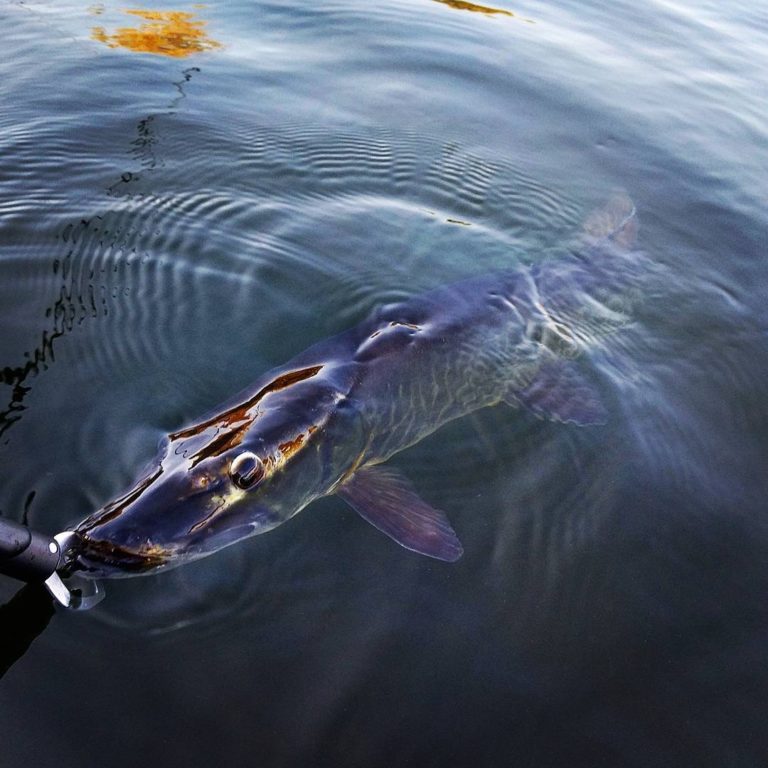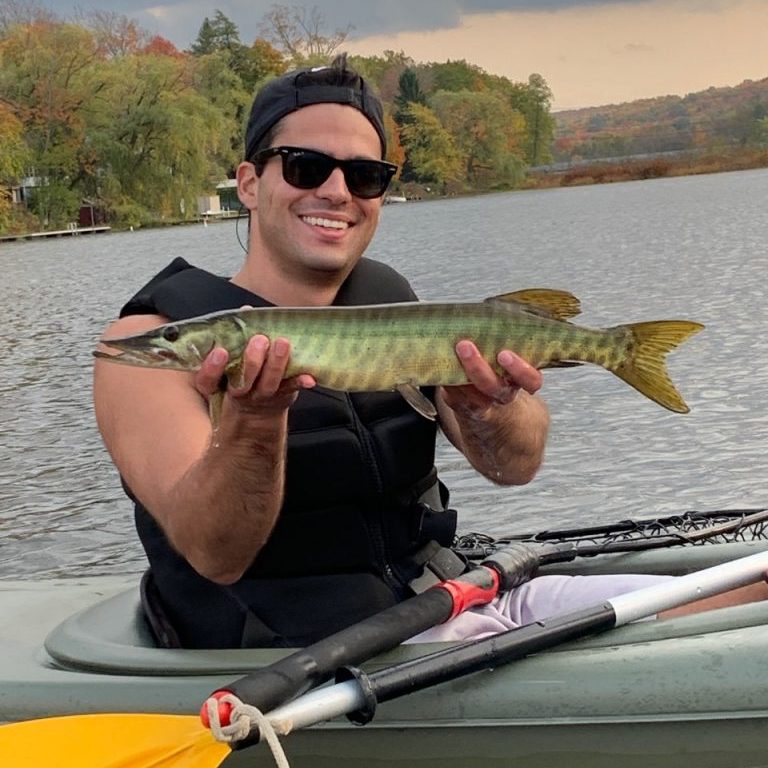The Muskellunge

The muskellunge (Esox masquinongy) is a prized sport fish found in some areas of western New York. Muskellunge typically range between 35 and 55 inches in length and can be identified by their tan/gray body, reddish brown fins, large size, and toothy mouth. The muskellunge is the apex predator and largest fish species that can be legally targeted in western New York.
Interestingly, there are two distinct strains of muskellunge found here in western New York and the appearance of these strains is a bit different. The first strain is referred to as the Great Lakes strain. The Great Lakes strain of muskellunge is found in the Niagara River, in Lake Erie and Ontario, and in the St. Lawrence River. Great Lakes strain muskellunge have either a clear or spotted coloration. The second strain is called the Ohio River strain. The Ohio River strain of muskellunge is found in the large lakes and warm-water creeks and rivers of Chautauqua and Cattaraugus Counties. Ohio River strain muskie have a barred color pattern.
The two strains of muskellunge should not be confused with the tiger muskellunge, which is a sterile hybrid of a muskie and a northern pike. Tiger muskellunge are typically smaller than a true muskellunge and always exhibit a barred or tiger like color pattern. The easiest way to distinguish between a tiger muskie and a true muskie is the shape of the tail fin. True muskies have a pointed tail fin, while the tips of a tiger muskie’s tail are rounded.
Habitat
Muskellunge usually roam big water and are therefore found in lakes, rivers, and large creeks. In order to support an apex predator like the muskellunge, a lake or river needs a large forage base. In lakes, muskellunge typically cruise the weedline, feeding on fish that venture too far out of the cover of the weeds. Muskie can sometimes be found just inside the weedlines ambushing prey. Rumor has it that the largest of muskie cruise the open water in big lakes.
Muskie also inhabit large, warm-water creeks and rivers and they do well in the deep, sluggish sections of large creeks. It is possible but very rare to find musky in the shallower areas of creeks such as flats or runs. Muskie will often seek cover around submerged trees or in deep undercut banks.
Food
Muskie are voracious and opportunistic predators. A muskellunge’s diet will primarily consist of fish. Muskellunge have been known to eat anything among chubs, suckers, and sunfish including bass. It is not uncommon to have a musky take a bass being played by an angler.
Where to Catch Muskellunge
Muskie inhabit some large lakes in western New York and Lake Erie and Ontario. In Erie County, the most popular place to target muskie is the upper Niagara River. The upper Niagara River is considered a world-class muskie fishery by many and produces fish over 50 inches. The upper Niagara River is best fished by boat. Fishing the upper Niagara by boat requires a good deal of knowhow, so hiring a guide is not a bad idea. However, it is possible to catch muskie from the shore. Once in a blue moon, a nice muskie is taken from the Niagara by shore anglers at public fishing access sites.
Lake Chautauqua is probably the crown-jewel muskie fishery of western New York and is considered by some to be the muskie capital of the world. It’s hard to argue with the numbers at Lake Chautauqua. Even though Chautauqua boasts a very large population of muskie, they are still very challenging to catch and a boat is usually needed. You could take your chances fishing from shore but the vast floating weed mats make casting to open water difficult.
Other lakes in Chautauqua County that hold muskie include Bear and Cassadaga lakes. These lakes are small and can be fished from a kayak. However, the fishing pressure on these lakes is usually high and Cassadaga Lake is used extensively for recreational boating, making kayaking a bit tough at times. Yet again, it is very challenging to fish these small lakes while competing against seasoned muskie anglers that travel here from as far as Pennsylvania.
Another place to fish for muskie is the warm-water creeks of Chautauqua and Cattaraugus counties. Cassadaga Creek, which begins at Cassadaga Lake, is stocked yearly by the NY DEC. However, from experience, this creek can be difficult to fish in the summer as it can run very low. The Conewango Creek system is another option that is stocked with muskellunge.
The best time of year to fish for muskie is the fall. During the fall, water temperatures drop and muskies become more aggressive. Muskie likely feed heavily from September through November in order to stock their energy reserves for the winter. Muskie season closes November 30 (except for the lower Niagara River).

How to Catch Muskellunge
Muskie can be caught on both live bait and artificial lures. Good live bait includes large chubs or 10 to 12 inch suckers fished under a float. When fishing live bait, targeting weedlines is probably the best strategy.
Popular artificial lures for muskie include large stick or jerk baits 8 to 12 inches in length and oversized inline spinners. Muskie can be taken either by trolling or casting. When trolling, spread the water column to cover as much water as possible. Good places to focus when trolling are (unsurprisingly) weed lines. In order to entice a muskie, you usually need to troll at a relatively fast pace.
Stick baits, jerk baits, and inline spinners can also be fished by casting. Cast your bait as far as possible and vary your retrieval. Rumor has it that presentation is key. Covering water is crucial when muskie fishing. As they say, muskie are the fish of ten thousand casts.
